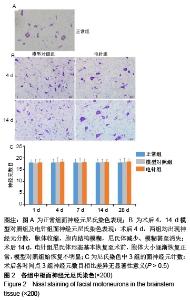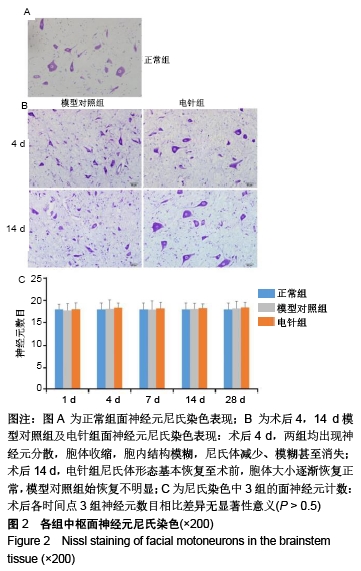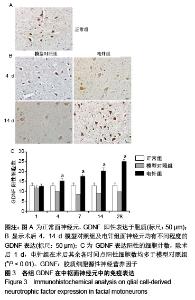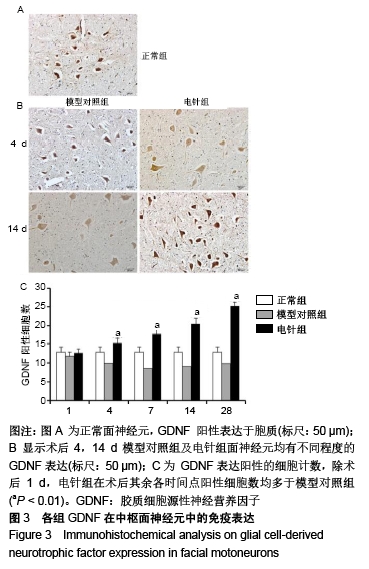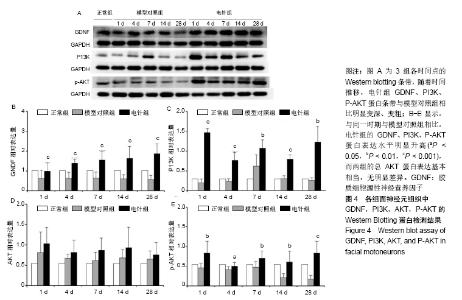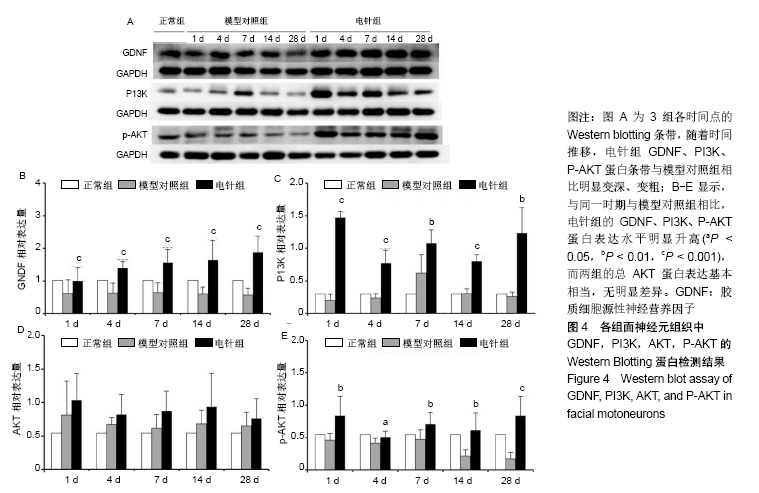[1] LI Y, WU X, HU KM, et al. Current Situation and Evaluation of Clinical Studies on Acupuncture and Moxibustion Treatment of Peripheral Facial Paralysis at Selected Stages. J Tradit Chin Med. 2010;30(2):153-159.
[2] 梁慧,李卓荣,林海波,等. 弥可保离子导入结合平衡针治疗周围性面瘫疗效观察[J].中国针灸,2018, 38(9):49-54.
[3] 韦艳丽,刘江,黄霞.中医治疗周围性面瘫研究近况[J].中医临床研究,2018,10(13):135-138.
[4] 周淼.周围性面瘫急性期针灸治疗的临床探讨[J].临床医药文献电子杂志, 2018,5(76):33-36.
[5] SHIN HK, LEE SW, CHOI BT. Modulation of neurogenesis via neurotrophic factors in acupuncture treatments for neurological diseases. Biochem Pharmacol.2017;141:132-142.
[6] 孙运花,李瑛,彭晓华,等. 急性期电针对面神经损伤模型兔的影响[J]. 时珍国医国药,2011,22(11):2776-2777.
[7] 刘立安,孙佰君.根据表面肌电图选穴电针治疗周围性面瘫临床观察[J].中国针灸,2015,35(6):553-556.
[8] 李雷激,徐超然,覃纲,等.面神经损伤后面神经核中神经型钙黏附分子及胎盘型钙黏附分子的表达[J].中国组织工程研究,2015, 19(37):5978-5982.
[9] IBÁÑEZ CF, ANDRESSOO JO. Biology of GDNF and its receptors – Relevance for disorders of the central nervous system. Neurobiol Dis.2016:97(Pt B):80-89.
[10] DU F, WANG L, QIAN W, et al. Loss of enteric neurons accompanied by decreased expression of GDNF and PI3K/AKT pathway in diabetic rats. Neurogastroenterol Motil, 2009;21(11):1229-e114。
[11] 孙运花,李瑛,张薇,等.压榨性面神经损伤模型在电针机理研究中的应用[J].辽宁中医杂志,2012,39(1):141-143.
[12] 牙祖蒙.穴位针刺对面神经再生影响的动物模型制作[J].实验动物科学与管理,1999,16(1):15-17.
[13] 费静,王长黎,李雷激.电针对面神经损伤后上皮钙黏素和钙调素在面神经元中表达的影响[J]. 实用医学杂志, 2018,22(28): 103-109.
[14] 牙祖蒙,王建华,李忠禹,等.穴位针刺对面神经再生影响的实验研究[J]. 针刺研究,1999,24(02):111-115.
[15] TANG H, FENG S, CHEN J, et al. Effects of Electroacupuncture on Facial Nerve Function and HSV-1 DNA Quantity in HSV-1 Induced Facial Nerve Palsy Mice. Evid Based Complement Alternat Med.2014; 2014:1-7.
[16] TAKAHASHI H, HITSUMOTO Y, HONDA N, et al. Mouse Model of Bell’s palsy Induced by Reactivation of Herpes Simplex Virus Type 1. J Neuropathol Exp Neurol.2001; 60(6):621-627.
[17] 陈静,孙羽,孟艳,等.脂筏在GDNF与其受体相互作用中的意义[J]. 神经解剖学杂志,2014,30(1):70-74.
[18] BOBARNAC DOGARU GL, JUNEJA SC, SHOKRANI A , et al. The role of Hedgehog-responsive fibroblasts in facial nerve regeneration. Exp Neurol.2018;303:72-79.
[19] CATTIN AL, LLOYD AC. The multicellular complexity of peripheral nerve regeneration. Curr Opin Neurobiol. 2016;39: 38-46.
[20] 李海燕.电针为主综合治疗周围神经损伤19例[J].山东中医杂志, 2010,29(2):105-105.
[21] 胡琳娜,邵水金,刘延祥,等.电针治疗周围神经损伤的修复机制[J]. 中国组织工程研究,2010,14(46):8662-8664.
[22] 孙运花,李瑛,张薇,等. 急性期电针对面神经损伤模型兔JAK1-STAT3信号通路的影响[J].辽宁中医杂志, 2012,39(2): 368-369.
[23] 王坤,黄德裕,苗芳,等.电针治疗特发性面神经麻痹急性期疗效的系统评价[J].广州中医药大学学报, 2018,35(2):276-283.
[24] 魏海刚,李蜀光,陈玉婷,等.神经损伤诱导面神经运动神经元死亡及caspase相关蛋白的表达[J].上海口腔医学,2015,24(1): 23-29.
[25] KIM J. Neural reanimation advances and new technologies. Facial Plastic Surgery Clin North Am. 2016;24(1):71-84.
[26] 徐进旺,李爱民,刘希光,等. 米诺环素对大鼠面神经缺血损伤模型面运动神经元细胞凋亡及Bcl-2、Bax表达的影响[J]. 实用医学杂志,2015,31(23):3826-3830.
[27] LIN LF, DOHERTY DH, LILE JD, et al. GDNF: a glial cell line-derived neurotrophic factor for midbrain dopaminergic neurons.Science.1993;260(5111):1130-1132.
[28] HENDERSON CE, PHILLIPS HS, POLLOCK RA, et al. GDNF: A potent survival factor for motoneurons present in peripheral nerve and muscle. Science.1994;266(5187): 1062-1064.
[29] BARRAS FM, PASCHE P, BOUCHE N, et al. Glial cell line-derived neurotrophic factor released by synthetic guidance channels promotes facial nerve regeneration in the rat. J Neurosci Res. 2002;70(6):746-755.
[30] FEI J, GAO L, LI HH , et al. Electroacupuncture promotes peripheral nerve regeneration after facial nerve crush injury and upregulates the expression of glial cell-derived neurotrophic factor. Neural Regen Res. 2019;14(4):673-682.
[31] 吴斗,刘强,陈君长,等.外周神经损伤大鼠的脊髓运动神经元组织形态学观察[J].山东医药,2006,46(12):23-24.
[32] 成光宇,丛婷婷,吕美香,等. 解毒通络保肾法对高糖刺激下小鼠足细胞PI3K/AKT信号通路活化相关因子ILK、AKT及足细胞凋亡率的影响[J]. 中国老年学杂志,2019,39(5):1174-1176.
[33] ZHANG YP, LIU SY, SUN QY, et al.Proanthocyanidin B2 attenuates high-glucose-induced neurotoxicity of dorsal root ganglion neurons through the PI3K/Akt signaling pathway. Neural Regen Res. 2018;13(9):1628-1636.
[34] EDSTRÖM A, EKSTRÖM PA . Role of phosphatidylinositol 3-kinase in neuronal survival and axonal outgrowth of adult mouse dorsal root ganglia explants.J Neurosci Res.2003; 74(5):726-735.
[35] ALGHADEER S, HORNSBY L . Assessment of Novel Oral Anticoagulant use within a Community Teaching Hospital. Saudi Pharm J.2016;25(1):93-98.
|


